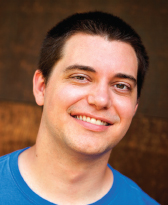Student Profile with Introduction
PROFILE


Daniel Graham, 24
Computer Science Major, Harold Washington College

Daniel Graham from Harold Washington College, a two-year college in the City College of Chicago system, didn’t have much knowledge of how he learned before he started college. In his first term, he enrolled in a college success seminar, in which he discovered that people learn differently, and these ways of learning are referred to as learning styles. He also took a learning styles inventory and discovered that he learns best by doing and by reading and writing down material from class. In a recent interview, Daniel explained how he has successfully used several strategies that apply specifically to his form of learning: He rewrites terms and concepts in his own words so that he better understands what they mean, and he uses note cards to help him memorize. Daniel says, “Knowing how I learn has improved my performance. When I take notes, I read them silently on note cards and continue to return to them, so I can memorize the meaning.”
“Knowing how I learn has improved my performance.”
Daniel is not surprised that he learns by doing because, like many other two-year college students, he spends ten to fifteen hours a week working. Daniel’s family owns a landscaping business and employs him part-time. “A hands-on approach has my name written all over it,” he says. “I like being able to use my hands and express myself, and I like being able to figure things out just by playing with them for a bit.” He adds that he uses this hands-on approach in college by doing things like taking practice exams until he feels ready for the real exam.
In the future, Daniel plans to finish his associate’s degree and then explore job opportunities. In ten years, he hopes to be working in computer science, and he plans to continue to rely on his learning styles. He advises fellow students: “Apply your learning style to your everyday life. Eventually, you will learn in a different, smarter, and more efficient way.”
Have you ever thought about how you learn? If not, it would probably help to think about this topic now that you are in college. People learn differently. This is hardly a new idea, but if you are to do well in college, it is important that you become aware of how you prefer to learn. Maybe you have trouble paying attention to a long lecture, or maybe listening is the way you learn best. You might love classroom discussion, or you might consider hearing what other students have to say in class a big waste of time.
Perhaps you have not thought about it, but college instructors have their own styles of teaching and communicating. Those different styles will be evident in the way that courses are organized and taught. Your preferred style of learning might not match up with the way some of your courses are taught. Many instructors just lecture; others use lots of visual aids, such as PowerPoint presentations, charts, graphs, and pictures. In science courses, you will conduct experiments or go on field trips where you can observe or touch what you are studying. In dance, theater, or physical education courses, learning takes place in both your body and your mind. And in almost all courses, you’ll learn by reading textbooks and other materials. Some instructors are friendly and warm, particularly in two-year colleges with their focus on teaching; others seem to want little interaction with students.
This chapter will help you first to understand how you learn best and then to think of ways in which you can create a link between your style of learning and the expectations of each course and instructor. This chapter will also explore learning disabilities, which are common among college students. You will learn how to recognize them and what to do if you or someone you know has a learning disability.